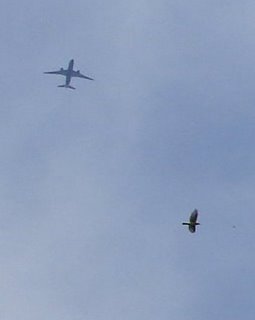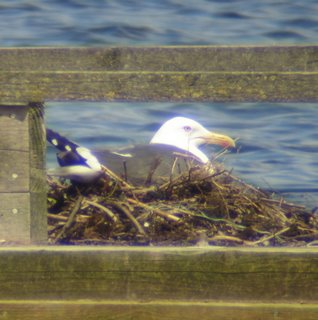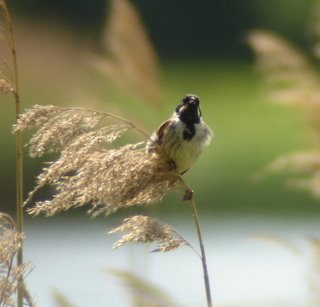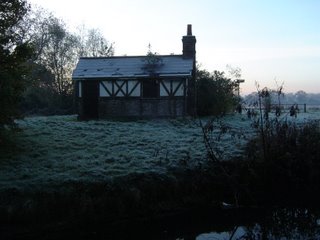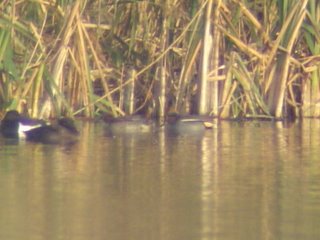Highlights:
Garganey - one on 5th Sep
Pied Flycatcher - one on 3rd-5th Sep
Spotted Flycatchers - at least six in Aug & Sep
Tree Pipit - one on 3rd Oct
Red-crested Pochards - six records of up to 11 birds
heavy
warbler passage in Aug & Sep

Late summer and autumn migration was impressive and sustained, especially regarding the numbers (and variety) of warblers moving through; complimenting these were other notable passerines, including flycatchers, pipits and finches, and visible migration/flyovers confirmed the skies were worth watching. Wildfowl also proved interesting, providing scarcities and high counts of commoner species.
Counts of
Phylloscopus warblers were perhaps most surprising.
Willow Warbler numbers, after single figures during the first week of Aug, swelled to consistent double-figure counts between 8th Aug and 20th Sep, with between 10 and 20 birds the norm. Counts of over 20 were made on 18th Aug (30), 26th Aug (22) and 5th Sep (21). Numbers fell sharply by the last week of Sep, with single figures recorded until the last record of one on 3rd Oct.

(Shoveler & Black-headed Gull, Aug 2005)
Such numbers made the picture rather blurred regarding exactly how many birds were involved, but no doubt much overlapping and changeover occurred. This was also the case with
Chiffchaff counts, which were hardly less impressive; sustained peaks were, as expected, slightly later than the last species, with single figure counts in the first half of Aug building up to double figures by the second half, with 10 on 15th, 22 on 18th, 18 on 26th and 25 on 31st.
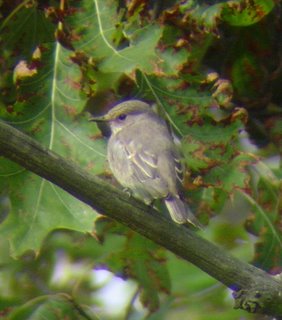
(Spotted Flycatcher, West Res, 20th Sep 2005)
Sep continued to provide healthy counts, with 20 on 2nd, 28 on 5th, 18 on 7th, 10 on 13th, 11 on 20th, 16 on 23rd and 10 on 26th. Oct saw counts greatly reduced, with peaks of 8 on 3rd and seven on 7th, and movements effectively ended by the middle of the month (although up to three were present to the year's end).
Sylvia warblers also impressed, with records of all four commoner species exceeding expectations.
Garden Warblers were recorded on six dates during Aug, with three on 1st, two on 8th, and singles on 4th, 9th, 15th and 31st.
Blackcaps were present in small numbers throughout Aug and Sep, usually between one and four being recorded, with an isolated peak of 12+ on 18th Aug, and a last record of two on 7th Oct.

(Holly Blue, Sep 2005)
Common Whitethroats were present in small numbers on most visits in Aug, with a high count of 12 on 18th (the day of an unprecedented 'fall' of many migrant passerines). Last recorded on 5th Sep (two), and at least one pair bred by the West Reservoir.
Lesser Whitethroats were recorded on four dates in Aug, with two on the 8th and singles on 9th, 15th and 18th.
Of other notable migrant passerines, flycatchers and pipits arguably provided the highlights. A minimum of six
Spotted Flycatchers moved through, with two on 26th Aug, four on 20th Sep and two on 23rd Sep constituted a surprising run of autumn records; a single
Pied Flycatcher was very welcome on the 4th & 5th Sep.
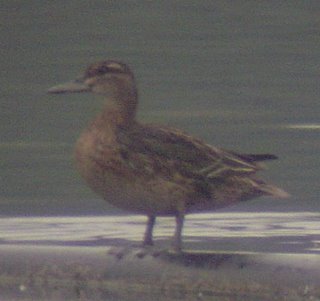
(Garganey, East Res, 5th Sep 2005
All records of
Meadow Pipits fell between mid-Sep and mid-Oct, and usually involved small groups moving over the area (although occasionally birds alighted). Visible migration began with five on 20th Sep, and continued with 15 on 23rd Sep, two on 26th Sep, 18 on 3rd Oct, and six on 11th Oct. A single
Tree Pipit dropped into scrubby wasteground just north of the West Reservoir on the 3rd Oct.
Hirundine passage was heavy at times, as pre-migratory birds gathered to feed over the reservoirs, and was dominated by
House Martins. Large congregations, especially over the East Reservoir, were present on several dates during Aug and Sep (as well as smaller numbers on many other occasions), including: Aug - 90 on 1st , 35 on 2nd, 30 on 12th, 65 on 15th, 130 on 26th; Sep - 50 on 20th and 65 on 23rd. Most local breeders appeared to leave the area around the first week of Sep. (At least three pairs bred at the junction of Rectory Road and Evering Road.)

(Wood pigeon passage, Oct 2005)
Sand Martins were seen in small numbers - usually one to three, but up to six - on six dates between 8th Aug and 20th Sep. A large mixed Hirundine flock feeding over the ER on 26th Aug included 90 Sand Martins, far and away the highest count. The last record was of two birds on 23rd Sep.
Swallows were much scarcer, with several singles and an isolated peak of 17 on 23rd Sep.
 Common Swift
Common Swift congregations peaked in early Aug, with 55 on 1st, 80 on 2nd, 110 on 4th , 50 on 8th and 35 on 12th. The last bird was seen on 26th Aug.
Kingfishers were seen on almost every occasion, usually favouring the New River East. One (or, more often) two usually present, with three on 18th Dec.
Jackdaws were recorded three times in Oct, with five overhead on 3rd, six on 11th, and one on 27th.
Finch passage was evident in Sep and Oct - especially regarding flyovers - and although few definitive counts were made, numbers of
Chaffinch,
Greenfinch and
Goldfinch rose significantly during the period. Three scarcer species were also recorded; a single
Brambling fed with Chaffinches at the East Reservoir on 7th Oct, three
Siskins were present on 26th Sep, and two
Linnets flew over on 3rd Oct.

(Red-crested Pochards, Sep 2005)
Sky-watching provided plenty of interesting results with many finches, most pipits, Jackdaws and other species being picked up overhead, and visible migration was especially impressive concerning movements of
Woodpigeons.
Numbers increased during late Sep and especially Oct, when several hundred overhead during a several-hour session was not unusual; exceptional visible migration occurred on the morning of 27th Oct, when a minimum of 2300 passed west and southwest over the East Reservoir between 0730 and 1030hrs.
Raptors were as expected, with
Sparrowhawks being the commonest and most reliable.
Kestrels were irregular, and a
Peregrine hunted over the East Reservoir just after dawn on 4th Aug. Wader records were confined to a single
Common Sandpiper at the West Reservoir on 13th Sep.

(Grey Heron, New River, Aug 2005)
Grey Herons were always present, with an average of two to four birds recorded; noticeably more common in Aug, with up to six birds present (including several juveniles). Ten to 25
Cormorants were usually recorded, with a peak of 34 on 24th Nov.
Common Terns were regularly seen, most records refering to a family party of three birds (two adults and a juv) present during the first half of Aug. The Juvenile often begged, and the adults often responded accordingly. Gull numbers, as expected, were generally low, with between three and twelve
Lesser Black-backed Gulls and one to three
Herring Gulls (erratically) complimenting a steady build up of
Black-headed Gulls - the commonest gull in the area, with numbers building steadily from 15-30 in early Aug to 70+ by mid-Oct.
Spot counts of
Coot were made on 15th Aug (103) and 20th Sep (178), and remained high well into Oct, while the first record of
Water Rail came on the 27th (with a wintering population of at least four birds thereafter).

(Spotted Flycatcher, West Res, 20th Sep 2005)
Despite sustained nocturnal passage on many nights in the borough from 10th Oct to mid-Nov,
Redwings were only recorded for the first time in the light of day on 27th, with 28 at/over the East Reservoir; flocks of
Mistle Thrushes, meanwhile - apparently gathering before roosting nearby - included 30 on 4th Sep, 20 on 3rd Oct and 12 on 7th Oct.

Wildfowl counts were made regularly, and of the commoner species,
Tufted Ducks were most numerous, with between 60 to 70 often counted;
Shovelers were present on all visits in varying numbers, with counts of more than 25 as follows: 34 on 26th Aug, 30 on 7th Sep, 28 on 23rd Sep, 38 on 26th Sep, 35 on 3rd Oct, 30 on 7th Oct; and counts of
Gadwall rose to 40 or above for most of the autumn.
Pochards were also omnipresent throughout, with usually 25 to 40 birds present, while counts of
Ruddy Ducks varied between 12 and 25 birds.

(Garganey, East Res, 5th Sep 2005)
Three records of
Wigeon involved two (eclipse m and f) on 26th Aug, five on 13th Sep and two on 20th Sep. All records of
Red-crested Pochard fell between mid-Aug and mid-Sep on the East Reservoir: one (eclipse m) 18th Aug, one (f) 26th Aug, two 2nd Sep, one (f) 5th Sep, four (2m, 2f) 7th Sep, and two 13th Sep.
The wildfowl highlight of the autumn was undoubtedly a
Garganey which appeared on the ‘gull rings’ of the East Reservoir on 5th Sep.

(Red Admiral, 5th Sep 2005)




